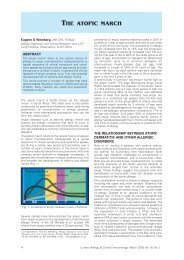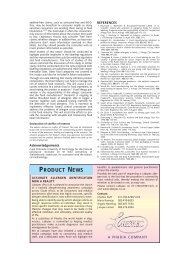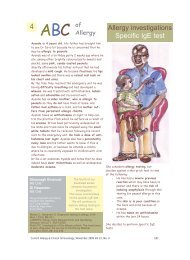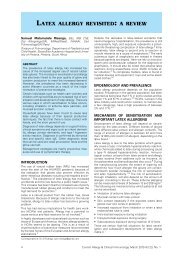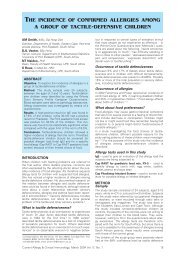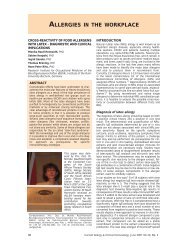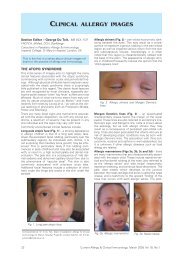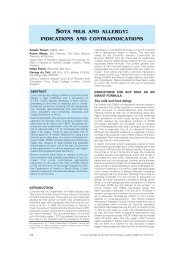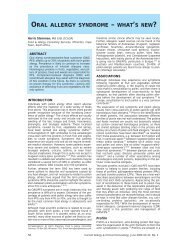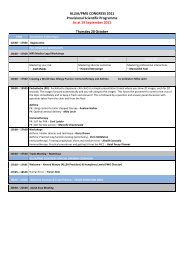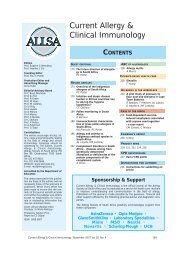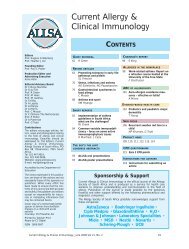Current Allergy and Clinical Immunology - March 2008
Current Allergy and Clinical Immunology - March 2008
Current Allergy and Clinical Immunology - March 2008
Create successful ePaper yourself
Turn your PDF publications into a flip-book with our unique Google optimized e-Paper software.
e-evaluation of serum immunoglobulin concentrationssince hypogammaglobulinaemia may be transient <strong>and</strong>resolve spontaneously. 45,46IVIG is not indicated in IgA deficiency. In patients withIgA deficiency, transient hypogammaglobulinaemia ofinfancy or isolated IgG subclass deficiency plus recurrentinfections, prophylactic antibiotics may be administered,using amoxicillin (twice daily) or azithromycin(weekly). In transient hypogammaglobulinaemia ofinfancy IVIG replacement may be used in children withsevere, recurrent infections until immunoglobulin productionnormalises. Patients with isolated IgG subclassdeficiencies account for the greatest misuse of IVIG.Immunoglobulin therapy should be used for a minorityof patients who are unable to produce specific antibody<strong>and</strong> continue to experience recurrent infectionsdespite prophylactic antibiotics. 35,39,40The treatment of HIGM syndromes includes theadministration of IVIG. In patients with X-linked HIGM,IVIG does not prevent the development of sclerosingcholangitis <strong>and</strong> malignancy. 17 Alternative therapieshave been employed successfully including granulocyte-colony-stimulatingfactor for neutropenia, allogenicbone marrow transplantation (BMT) or cord blood celltransplantation to cure X-linked HIGM, <strong>and</strong> combinedBMT <strong>and</strong> liver transplantation to addressX-linked HIGM complicated by end-stage liver failure.17,47-50 Similarly, X-linked lymphoproliferative syndromehas been treated with IVIG <strong>and</strong> BMT. 43OUTCOMEInadequate diagnosis or suboptimal treatment placesthe patient at risk of recurrent infections, organ-specificcomplications <strong>and</strong> early mortality. Recurrent respiratoryinfections may lead to bronchiectasis <strong>and</strong> end-stagelung disease with cor pulmonale <strong>and</strong> respiratory failure.Abnormal lung functions, usually an obstructive pattern,have been reported to be more common in CVIDthan in Btk deficiency. Lung functions should be monitoredregularly to ensure that IVIG replacement is optimisedto prevent these complications. 3,40Gastrointestinal disorders occur in 20-47% of patientswith primary antibody deficiencies. 3 Hepatic complicationsmay occur as a result of specific viral infectionssuch as hepatitis C <strong>and</strong> primary biliary cirrhosis, oftenassociated with Cryptosporidium parvum infection. InX-linked HIGM this invariably leads to end-stage liverfailure. 50 Primary antibody deficiencies are associatedwith an increased risk for malignancy, varying from 1.8-to 13-fold. Lymphoreticular malignancies, particularlynon-Hodgkin's lymphomas are most frequent. Othercomplications include disability arising from meningitis,neurodegeneration <strong>and</strong> autoimmune phenomena. 3,40Despite these problems many well-managed patientsrespond to appropriate treatment resulting in improvedlife expectancy <strong>and</strong> decreased infectious complications.In conclusion, many primary antibody deficiencies havebeen comprehensively characterised. The increasedknowledge has impacted favourably on treatment <strong>and</strong>long-term prognosis.Declaration of conflict of interestThe author declares no conflict of interest.REFERENCES1. De Vries E, for the <strong>Clinical</strong> Working Party of the European Societyfor Immunodeficiencies (ESID). Patient-centred screening for primaryimmunodeficiency: a multi-stage diagnostic protocol for nonimmunologists.Clin Exp Immunol 2006; 145: 204-214.2. Maródi L, Notarangelo LD. Immunological <strong>and</strong> genetic bases ofnew primary immunodeficiencies. Nat Rev Immunol 2007; 7: 851-861.3. Wood P, Stanworth S, Burton J, et al. Recognition, clinical diagnosis<strong>and</strong> management of patients with primary antibody deficiencies:a systematic review. Clin Exp Immunol 2007; 149; 410-423.4. Stiehm RE. The four most common pediatric immunodeficiencies.Adv Exp Med Biol 2007; 601: 15-26.5. Fischer A, Malissen B. Natural <strong>and</strong> engineered disorders of lymphocytedevelopment. Science 1998; 280: 237-243.6. Cunningham-Rundles C, Ponda PP. Molecular defects in T- <strong>and</strong> B-cell primary immunodeficiency diseases. Nat Rev Immunol 2005;5: 880-892.7. Geha RS, Notarangelo LD, Casanova J, et al. Workshp summary.Primary immunodeficiency diseases: an update from theInternational Union of Immunological Societies Primary ImmunodeficiencyDiseases Classification Committee. J <strong>Allergy</strong> ClinImmunol 2007; 120: 776-794.8. Bruton OC. Agammaglobulinaemia. Pediatrics 1952; 9: 722-728.9. Vetrie D, Vorechovsky I, Sideras P, et al. The gene involved in X-linked agammaglobulinaemia is a member of the src family of protein-tyrosinekinases. Nature 1993; 361: 226-233.10. Conley ME, Broides A, Hern<strong>and</strong>ez-Trujillo V, et al. Genetic analysisof patients with defects in early B-cell development. Immunol Rev2005; 203: 216-234.11. Pienaar S, Eley B, Beatty D, Henderson HE. X-linked agammaglobulinaemia<strong>and</strong> the underlying genetics in two kindreds. J PaediatrChild Health 2000; 36: 453-456.12. Conley ME. Early defects in B cell development. Curr Opin <strong>Allergy</strong>Clin Immunol 2002; 2: 517-522.13. Ferrari S, Lougaris V, Caraffi S, et al. Mutations of the Igbeta genecause agammaglobulinemia in man. J Exp Med 2007; 204: 2047-2051.14. Dobbs AK, Yang T, Farmer D, Kager L, Parolini O, Conley ME.Cutting edge: a hypomorphic mutation in Igbeta (CD79b) in apatient with immunodeficiency <strong>and</strong> a leaky defect in B cell development.J Immunol 2007; 179: 2055-2059.15. Minegishi Y, Rohrer J, Coustan-Smith E, et al. An essential role forBLNK in human B cell development. Science 1999; 286: 1954-1957.16. Etzioni A, Ochs HD. The hyper-IgM syndrome – an evolving story.Pediatr Res 2004; 56: 519-525.17. Levy J, Espanol-Boren T, Thomas C, et al. <strong>Clinical</strong> spectrum of X-linked hyper-IgM syndrome. J Pediatr 1997; 131: 47-54.18. Pienaar S, Eley BS, Hughes J, Henderson HE. X-linked hyper IgM(HIGM1) in an African kindred: the first report from South Africa.BMC Pediatr 2003; 3: 12. http//:www.biomedcentral.com/1471-2431/3/12.19. Jain A, Ma CA, Liu S, Brown M, Cohen J, Strober W. Specific missensemutations in NEMO result in hyper-IgM syndrome withhypohydrotic ectodermal dysplasia. Nat Immunol 2001; 2: 223-228.20. Salzar U, Grimbacher B. Update on common variable immunodeficiency(CVID). ESID Newsletter 2004; 3: 17-23.21. Cunningham-Rundles C, Bodian C. Common variable immunodeficiency:clinical <strong>and</strong> immunological features of 284 patients. ClinImmunol 1999; 92: 34-48.22. European Society for Immunodeficiency. Diagnostic criteria forPID. http//:www.esid.org (last accessed: 14 November 2007.)23. Weston SA, Prasad ML, Mulligghan CG, Chapel H, Benson EM.Assessment of male CVID patients for mutations in the Btk gene:how many have been misdiagnosed? Clin Exp Immunol 2001; 124:465-469.24. Eastwood D, Gilmour KC, Nistala K, et al. Prevalence of SAP genedefects in male patients diagnosed with common variable immunodeficiency.Clin Exp Immunol 2004; 137: 584-588.25. Grimbacher B, Hutloff A, Schlesier M, et al. Homozygous loss ofICOS is associated with adult-onset common variable immunodeficiency.Nat Immunol 2003; 4: 261-268.26. Van Zelm MC, Reisli I, van der Burg M, et al. An antibody-deficiencysyndrome due to mutations in the CD19 gene. N Engl J Med2006; 354: 1901-1912.27. Salzar U, Chapel HM, Webster ADB, et al. Mutations inTNFRSF13B encoding TACI are associated with common variableimmunodeficiency in humans. Nat Genet 2005; 37: 820-828.28. Castigli E, Wilson SA, Garibyan L, et al. TACI is mutant in commonvariable immunodeficiency <strong>and</strong> IgA deficiency. Nat Genet 2005; 37:829-834.29. Sekine H, Ferreira RC, Pan-Hammarström Q, et al. Role for Msh5in the regulation of Ig class switch recombination. Proc Natl AcadSci USA 2007; 104: 7193-7198.18 <strong>Current</strong> <strong>Allergy</strong> & <strong>Clinical</strong> <strong>Immunology</strong>, <strong>March</strong> <strong>2008</strong> Vol 21, No. 1



